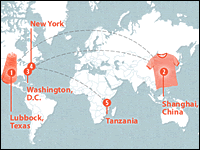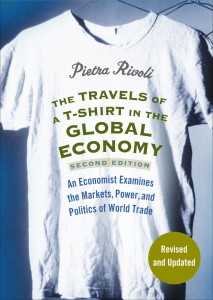The Travels of a T-shirt in the Global Economy – An Economist Examines the Markets, Power, and Politics of World Trade
by P. Rivoli
ISBN: 9780470287163
Do you know what the story is of that one silly souvenir T-shirt you bought ages ago and which remains lingering in the back of your wardrobe? No? Then this book is for you.
Pietra Rivoli uses a simple concept to learn, and tell, the story of the globalisation of world trade, specifically in the textile industry: She buys a random T-shirt while on holidays. She talks to the owners of the shop to find out where they bought it from – and starts to track down one buy one each of the factories and persons that (very likely) had a direct influence on how her T-shirt saw the light of day, and ended up in her hands.

Her story starts out at Washington D.C.’s George Town University and a demonstration of students protesting against the sweatshop conditions their university sweat and T-shirts likely were being produced under. The author stopped, listened to the concerned – and decided to find out how the ‘system’ (after all, the author is an economist!) works.
From there the story goes to Florida – where she buys the T-shirt, and then to Texas – where she surprisingly discovers the literal seed to what might have been the cotton of which her T-shirt was made of. Not in China, India or somewhere in Africa, but in Texas nearly at the doorsteps of where she herself lives.
The story of Pietra Rivoli’s T-shirt is fascinating as she goes back and forth between the details and ‘experiences’ of her own specific T-shirt, and the mechanisms of an entire industry, political decisions related to foreign trade, import quotas, massive scale lobbying and national protectionism.

But let’s take a closer look at the story line of ‘Travels of a T-shirt …‘.
The story starts right where the story of cotton starts itself – with the seed, and the process and challenges faced by the cotton farmers. At this stage this is a story chiefly determined by manual labour on the one hand, and cutting research and technology on the one hand. And story that lead the US to become not only the major cotton producer in the world, while at the same time being heavily supported by public subsidies and worst-case guarantees, government funds for agricultural research (including research into Genetically Modified Seed, new pesticides and herbicides), and change-resistant trade barriers.
Once the harvested cotton is gleaned and shipped, the next stage of the story takes place in China, from where the author depicts a landscape of clothing manufacturing as the stepping stone to the modernity for those trapped in rural poverty, of governmentally administered factories, of a population keen to be acknowledged for their work achievements – and of greedy business men, political manipulation, street-smart entrepreneurs, and international pressure from both businessmen and politicians overseas.
The third part of the story is the one of globalisation, the impact of trade barriers beyond the country they aim to protect. As such, the metaphorical T-shirt briefly catches glimpses of countries such as El Salvador, or Bolivia, the US, China, Cambodia – although to be fair, the author really only wants to introduce us more in depth into the economical and trade realities that the globalisation of the textile industry has brought along. And it is here that it becomes clear that the author, after all, is an economist: data, statistics, and plenty of other research back up the story that unravels piece by piece on us, with some of the most surprising conclusions. Among them, first and foremost, that trade is – at least as far as the industry of new clothing is concerned – not really free at all.
But then, most unexpectedly, our T-shirt takes yet another turn in its life path, and the story of second-hand clothing is brought to life. A story that for the first time indeed is one of free trade, economic innovation and user needs – yet it takes place away from the limelight, the newspapers, the discussion tables of trade policies and the corridors of power.
Every years millions of tons of garments are put into the rubbish bin and sent to the pit. Thankfully, more and more people opt for donating their unwanted items though to charitable organisation. Few however know what happens with their donated clothing, how the donated items are handled and process by the likes of Oxfam.
The author then, does exactly this. She describes the journey of clothing from the moment is given to the Salvation Army, through the first stage of sorting (suitable for charity shops), to the second stage of sorting (fishing out vintage, exportable, and separating that from scrap only) and how all ends up in different trading channels and even geographical locations. Vintage may turn up in Tokyo, scraps on the cleaning rag of a local factory floor. And everything in between, depending on fabrics, colours, prints and quality, in different corners of the world, from South America, to Africa and Asia.
At the end, ‘The travels of a T-shirt‘ are neither pro- nor anti-globalisation, but rather a quite balanced account of how the textile industry reality looks like in the present. The book is an fascinating read as it carefully balances the hard data with compelling case stories about individuals and their role in the bigger pictures.
Since the publication of the revised edition of the book, trade barriers – supposed to be abandoned by 2004 and prolonged until 2008 in the end, are finally gone. Yet, the question remains if this after all is a good thing, since very few are the winner – among them China – and many the losers.
This book is available from your nearest book store, as well as online from Amazon.
—————————–
Note: If you are interested in details about how the global used clothing trade works, make sure to also read: Salaula: The World of Secondhand Clothing and Zambia”, ISBN: 0226315819.
—————————–


